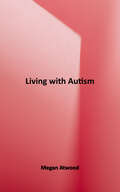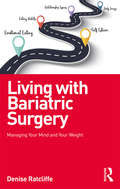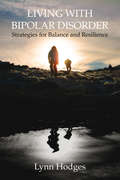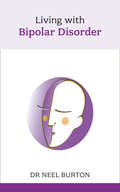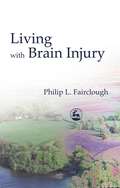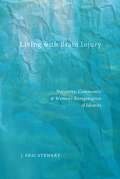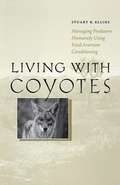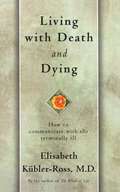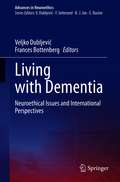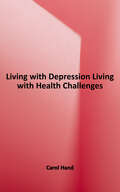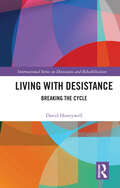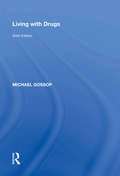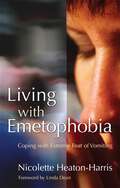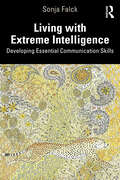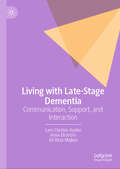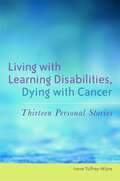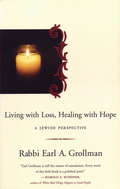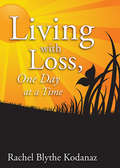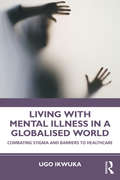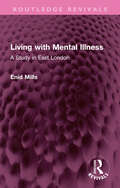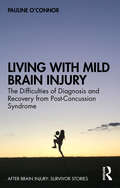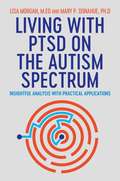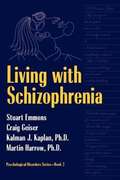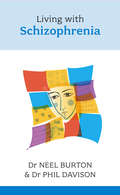- Table View
- List View
Living with Autism (Living with Health Challenges)
by Megan AtwoodLiving with Autism features fictional narratives paired with firsthand advice from a medical expert to help preteens and teenagers feel prepared for dealing with autism during adolescence. Topics include causes and prevention, current treatments, alternative treatments, public understanding and support, survival tools, learning to cope, ways to help friends with autism, and living with autism. Throughout the book, Ask Yourself these questions encourage discussion. Features include a selected bibliography, further readings, a Just the Facts summary of medical facts about addiction, where to Where-to-turn summary of key advice that includes contact information for helpful organizations, a glossary, source notes, and an index. Aligned to Common Core Standards and correlated to state standards. Essential Library is an imprint of Abdo Publishing, a division of ABDO.
Living with Bariatric Surgery: Managing your mind and your weight
by Denise RatcliffeLiving with Bariatric Surgery: Managing Your Mind and Your Weight aims to help those who are considering bariatric surgery develop a psychological understanding of their eating behaviour and the changes needed in order to make surgery successful. It is also a resource for those who have undergone surgery to help them adapt to the physical, psychological and relationship adjustments that occur. Whilst the benefits of bariatric surgery are significant, the psychological challenges it presents for patients have been overlooked. This book will help patients develop a realistic view of bariatric surgery and the changes required. It incorporates the real-life experiences of people who have had bariatric surgery, showing how they have responded to the psychological and behavioural changes after surgery, and also features helpful psychoeducation, exercises and strategies to facilitate reflection and learning. Living with Bariatric Surgery will be an essential guide for anyone considering, preparing for or recovering from bariatric surgery, as well as health professionals working with these clients.
Living with Bipolar Disorder
by Lynn HodgesFrom the initial diagnosis through recovery and transformation, this handbook offers positive, real-life solutions and support from one who not only suffers from the condition herself but has experienced it with her mother and her daughter. Her handy guide offers firsthand advice on how to lead a fulfilling life despite having this debilitating mental-health condition. In a practical, candid tone, the book focuses on addressing personal questions that arise following a diagnosis of bipolar disorder. Among the topics considered are the basics of functioning, living, and dealing with people on an everyday basis, how to negotiate treatment, handle family and friends, maintain a positive image, and make a living.
Living with Bipolar Disorder: Short Story
by Neel BurtonBipolar disorder affects around one in 100 people, and typically develops in late adolescence or early adulthood, affecting women and men equally. Often not recognized as an illness, it can cause years of suffering before it is properly diagnosed and treated. Like diabetes or heart disease, bipolar disorder is a long-term illness that must be carefully managed throughout a person's life. Living with Bipolar Disorder looks at relevant topics such as what bipolar disorder actually is, diagnosis, including differential diagnoses, and management using alternative, drug and psychological therapy.
Living with Brain Injury
by Philip FaircloughOn November 7th 1994, Philip Fairclough fell fifteen feet from a ladder onto a concrete patio. The impact caused massive trauma to his head and the subsequent brain damage he suffered has radically changed his life. At first unable to dress himself, cross roads on his own or tell the time, Philip underwent an intensive course of rehabilitation and occupational therapy, which slowly restored many of the lost skills that he had once taken for granted. His account tells of the hurdles he faced and overcame while in residence at a rehabilitation centre, the difficulties of readapting to family life, and finally the emergence of his new vocation as a writer. Like most of us, Philip never expected that severe injury would happen to him - but from the first he decided not to give up. His courage, determination and the support of his family characterize this account, which interweaves his own story with practical information about brain injury. Members of the medical profession, physiotherapists, occupational therapists and counsellors will all find this account helpful and revealing - as will people affected personally by brain injury, and their families and friends.
Living with Brain Injury: Narrative, Community, and Women’s Renegotiation of Identity (Qualitative Studies in Psychology #19)
by J. Eric StewartWhen Nancy was in her late twenties, she began having blinding headaches, tunnel vision, and dizziness, which led to the discovery of an abnormality on her brain stem. Complications during surgery caused serious brain damage, resulting in partial paralysis of the left side of her body and memory and cognitive problems. Although she was constantly evaluated by her doctors, Nancy’s own questions and her distress got little attention in the hospital. Later, despite excellent job performance post-injury, her physical impairments were regarded as an embarrassment to the “perfect” and “beautiful” corporate image of her employer.Many conversations about brain injury are deficit-focused: those with disabilities are typically spoken about by others, as being a problem about which something must be done. In Living with Brain Injury, J. Eric Stewart takes a new approach, offering narratives which highlight those with brain injury as agents of recovery and change in their own lives.Stewart draws on in-depth interviews with ten women with acquired brain injuries to offer an evocative, multi-voiced account of the women’s strategies for resisting marginalization and of their process of making sense of new relationships to self, to family and friends, to work, and to community. Bridging psychology, disability studies, and medical sociology, Living with Brain Injury showcases how—and on what terms—the women come to re-author identity, community, and meaning post-injury.
Living with Coyotes: Managing Predators Humanely Using Food Aversion Conditioning
by Stuart R. EllinsThe coyote may well be North America's most adaptable large predator. While humans have depleted or eliminated most other native predators, the coyote has defied all attempts to exterminate it, simultaneously expanding its range from coast to coast and from wilderness to urban areas. As a result, coyotes are becoming the focus of increasing controversy and emotion for people across the continent— from livestock growers who would like to eradicate coyotes to conservationists who would protect them at any cost.
Living with Death and Dying
by Elisabeth Kübler-RossIn this compassionate and moving guide to communicating with the terminally ill, Dr. Elisabeth Küebler-Ross, the world's foremost expert on death and dying, shares her tools for understanding how the dying convey their innermost knowledge and needs. Expanding on the workshops that have made her famous and loved around the world, she shows us the importance of meaningful dialogue in helping patients to die with peace and dignity.
Living with Dementia: Neuroethical Issues and International Perspectives (Advances in Neuroethics)
by Veljko Dubljević Frances BottenbergThis book addresses current issues in the neuroscience and ethics of dementia care, including philosophical as well as ethical legal, and social issues (ELSIs), issues in clinical, institutional, and private care-giving, and international perspectives on dementia and care innovations. As such, it is a must-read for anyone interested in a well-researched, thought-provoking overview of current issues in dementia diagnosis, care, and social and legal policy. All contributions reflect the latest neuroscientific research on dementia, either broadly construed or in terms of the etiologies and symptoms of particular forms of dementia. Given its interdisciplinary and international scope, its depth of research, and its qualitative emphasis, the book represents a valuable addition to the available literature on neuroethics, gerontology, and neuroscientific memory research.
Living with Depression (Living With Health Challenges Set 2)
by Carol HandLiving with Depression features fictional narratives paired with firsthand advice from a medical expert to help preteens and teenagers feel prepared for dealing with depression during adolescence. Topics include causes and risk factors, complications, tests and diagnosis, treatment methods, coping strategies, and giving and getting support. Throughout the book, Ask Yourself This questions encourage discussion. Features include a selected bibliography, further readings, Just the Facts summary of medical facts about depression, a where-to-turn summary of key advice that includes contact information for helpful organizations, a glossary, source notes, and an index. Aligned to Common Core Standards and correlated to state standards. Essential Library is an imprint of Abdo Publishing, a division of ABDO.
Living with Desistance: Breaking the Cycle (International Series on Desistance and Rehabilitation)
by David HoneywellIn this new and distinctive contribution to the desistance literature, Dr David Honeywell draws on his own lived experience to consider his route through youth delinquency and prison to a life away from crime through education, and ultimately towards academia. Drawing on perspectives from criminology, sociology and psychology, this autoethnography offers a unique perspective to the desistance process and to social identity. Honeywell considers possible convergences as well as marked differences between the desistance and the convict criminology literatures. While desistance scholars have often emphasised the need for ex-offenders to cast off their criminal identities, Honeywell demonstrates how his own trajectory has involved him embracing this identity to develop an academic career. In doing so, this book emphasises the complexity of the desistance process, and the role of stigma, and also of hope. An accessible and compelling read, this book will appeal to students and scholars of criminology, sociology, psychology and those interested in the lived experience of desistance.
Living with Drugs
by Michael GossopNow in its sixth edition, Living with Drugs continues to be a well-respected and indispensable reference tool. Michael Gossop has updated this new edition to take account of new laws and practices that have come in to place since the previous edition, published in 2000. Written in an accessible style and providing a balanced perspective, the book is ideal for non-specialists in training, such as student nurses and social workers and for anyone with an interest in this complex, ever-present and emotive issue.
Living with Emetophobia: Coping with Extreme Fear of Vomiting
by Nicolette Heaton-Harris Linda DeanEmetophobia, the extreme fear of vomiting, can affect just about every aspect of sufferer's life, from everyday considerations (`what food will be 'safe' for me to eat?') to matters that involve making huge, potentially devastating decisions (`I can't have this baby, I can't face morning sickness'). Nicolette Heaton-Harris has first-hand experience of the phobia and its effects. She suggests strategies for coping with the high levels of anxiety that are intrinsic to the phobia, as well as pre-empting and avoiding anxiety attacks. The experiences of fellow sufferers of all ages, male and female, are shared throughout the book and a list of useful organisations providing further information and support services is also included. Living with Emetophobia is a must-have for anyone suffering from emetophobia, anyone living with an emetophobic as well as professionals treating or supporting people with emetophobia.
Living with Extreme Intelligence: Developing Essential Communication Skills
by Sonja FalckIn Living with Extreme Intelligence: Developing Essential Communication Skills, Dr Sonja Falck provides a unique and practical manual of how to improve interpersonal interactions that involve adults who stand out from the neurotypical majority by having top 2% IQ. Her main message is that understanding the individual differences involved in extreme intelligence and mastering relevant communication skills can break through barriers of frustration, underachievement, and loneliness, to bring about brain-changingly positive conversations and interpersonal effectiveness, connection, and joy. Dr Falck begins by explaining the neurophysiological and social foundations of why we communicate the way we do, and then explains in detail seven essential communication skills. Following this, she shows how to put these skills into practice, applying insights from depth psychology and demonstrating how to have better conversations in a variety of contexts from general social gatherings to the workplace and intimate relationships. Particular attention is paid to areas that Dr Falck’s research and professional practice have repeatedly shown her are challenging for adults with extreme intelligence, such as small talk, office politics, dating, and handling conflict. She draws on case examples from her consulting work (psychotherapy and coaching) with clients who have extreme intelligence, and examples from novels, cinema, the media, the literature on giftedness, and biographical material on high-profile high-IQ figures like Steve Jobs, Elon Musk and Lady Gaga. Throughout she emphasizes the theme from her original model of interpersonal relating, which is that experiencing freedom of self-expression with others who offer you a high level of acceptance is what puts you in a state of thriving. The book provides step-by-step guidance for engaging in numerous interpersonal situations, such as how to handle difficult conversations, how to write effective emails, how to breathe, listen, play, take a risk, bond, repair a broken connection, and keep yourself well through changes like failure, success, and falling in love. It is essential reading for anyone affected by, or interested in, issues associated with extremely high intelligence.
Living with Late-Stage Dementia: Communication, Support, and Interaction
by Lars-Christer Hydén Anna Ekström Ali Reza MajlesiThis book investigates how people living with late-stage dementia can engage in communication and social interaction. Based on empirical research, it explores the remaining communicative resources of people living with cognitive impairment (e.g., intercorporeal interaction, bodily gestures, gaze), presenting the agency of the person with dementia as an integral part of their relations with others. The book provides a comprehensive theoretical framework for analyzing, describing, and understanding communication in late-stage dementia, and explores the use of video ethnography to record and analyze non-verbal, bodily interaction. The authors skilfully bring together findings from their examinations of everyday interactions involving individuals living with late-stage dementia in nursing facilities, introducing the readers to the innovative theoretical and methodological approaches that undergird the fine-grained analyses at the heart of the book. The rich and nuanced case studies collected encompass embodied directives, habitual actions and objects, physical settings, assisted eating, and much more. An invaluable resource for graduate students and researchers at all levels in the fields of psychology, psychotherapy, social work, nursing, gerontology, and related disciplines, this volume makes an unparalleled contribution to current dementia research across the social sciences.
Living with Learning Disabilities, Dying with Cancer
by Irene Tuffrey-WijneThis book is a powerful and moving account of the experiences of 13 people with learning disabilities who were living with cancer. The author followed their lives as part of a 3-year research study, during which 10 people died. She spent extensive periods of time with them at their homes and day centres, in hospitals, hospices and nursing homes. In doing so, she gained a unique understanding of what it is like for individuals with learning disabilities to live with deteriorating health and how this may impact upon their families, friends and carers. How was each person's cancer diagnosed? How was their cancer and its implications explained to them? How much did they understand and how did they cope with treatment? What happened when they were dying? In answering these questions, the book exposes the suffering of people with learning disabilities at the end of their lives, but also their remarkable resilience and strength. In an optimistic final chapter, the author demonstrates how people with learning disabilities can best be supported at the end of life. This book will be an invaluable resource for anyone involved in the care and support of people with learning disabilities who have cancer and who are dying, including health and social care professionals, families and friends.
Living with Loss, Healing with Hope
by Earl A. GrollmanEarl Grollman's Living When a Loved One Has Died has brought comfort to more than 250,000 readers. In Living with Loss, Healing with Hope, Grollman speaks directly to mourners of the Jewish faith. By weaving quotations from Jewish writers and philosophers into his comforting and expert prose, Grollman guides readers through the journey of mourning, healing, and hope.A colleague of Grollman's once told him, "Earl, I am not a member of your faith, but if I wanted the soundest emotional and spiritual approach to death, I would be a Jew." Occasionally quoting from sacred texts as well as Jewish writers and philosophers, Living with Loss, Healing with Hope illuminates Judaism's powerful recognition of the trauma of grief and of the mourner's responsibility eventually to return to the rhythm of life. In a brief final section, the author guides readers through Jewish funeral observances, Shiva, and beyond, and reminds all that these symbolic customs are 'about change-remembrance, letting go, and moving on.'
Living with Loss: One Day at a Time
by Rachel Blythe KodanazWhile exploring the hardships of loss by providing daily encouragements to help a griever through their personal journey, this book focuses on all aspects of life. It embraces and emphasizes the happy, healthy days of life with your loved one and how the loss has changed that life while integrating the loss into daily lives providing healing tools and suggestions.
Living with Mental Illness in a Globalised World: Combating Stigma and Barriers to Healthcare
by Ugo IkwukaLiving with Mental Illness in a Globalised World systematically examines the manifold contributions to the burdens of living with mental illness in a developing and globalised world. It explores the stigma of mental illness, the burden of which compares to the symptoms of and is sometimes considered more disabling than the illness itself. The book starts by reviewing the socio-psychological and cultural processes that contribute to stigma and providing evidence-based interventions to combat it. Chapters critically investigate the ideological and instrumental barriers to mental healthcare and establish that determining the conceptualisations of mental illness helps to unravel the reasons for the underutilisation of mental health services. A compelling case is made for a complementary healthcare model and bottom-up approach that is sensitive to the spiritual and cultural needs of the people. The text’s specific examination of mental healthcare in African countries makes it a timely piece for assisting mental health professionals in understanding the inequities in care that Black Asian and Minority Ethnic groups face and how to improve mental healthcare and delivery to these groups.
Living with Mental Illness: A Study in East London (Routledge Revivals)
by Enid MillsThe Mental Health Act of 1959 marked a turning point in national policy on mental illness. Originally published in 1962, this book reports a sociological survey of a group of people from an East London borough who entered a large mental hospital in 1956 and 1957, at the very time when a Royal Commission was preparing the report upon which the new legislation was based. Living with Mental Illness shows what happened to these mental patients and to their relatives, and tells of their reactions and impressions. The impact of mental illness on their domestic and social circumstances is described, as is the part played in their lives by the social services; and the relationship between people’s perceptions of mental illness and their attitudes to hospital is discussed. Enid Mills considers the prospects for ‘community care’ of the mentally ill in the borough studied, and concludes, as Professor Morris Carstairs says in his Foreword, with ‘a review of the difficulties which must be overcome if the transition is to be effected from an outmoded, remote mental hospital system to a community-based service which will be at once efficient and humane’.
Living with Mild Brain Injury: The Difficulties of Diagnosis and Recovery from Post-Concussion Syndrome (After Brain Injury: Survivor Stories)
by Pauline O'ConnorThis important book presents a unique, personal account of the impact a mild traumatic brain injury can have. It tells the story of Pauline, who was 33 when a late football tackle caused a bleed in her brain which went undiscovered for 18 months. The account includes descriptions of hidden symptoms of concussion and post-concussion syndrome, pitfalls in diagnoses, the uneven progress of recovery and the effect of the varied reactions which others have to an acquired brain injury. The author incorporates memories alongside extracts from clinic notes, diary entries and emails to reflect the disjointed progress of diagnosis and recovery as- although similar- no two head injuries are the same. Through this book, the reader gains an appreciation of the confusion experienced by many brain injury survivors, which sheds light on why some may develop unusual behavior or mental health issues, and how such issues can be alleviated. Brain injuries are poorly understood by the general public and this can lead to difficult interactions. Moreover, complications in diagnosis means some may not realize they have this milder form of brain injury. This book will enlighten brain injury survivors and affected families and allow professionals an insight into their patients’ experiences. As concerns grow over the risks which contact sports pose, this book shows how even mild brain injuries can wreak havoc with careers, relationships and one’s sense of self, but that a happy life can still be found.
Living with PTSD on the Autism Spectrum: Insightful Analysis with Practical Applications
by Lisa Morgan Mary DonahueThe relationship between autism and PTSD has historically been neglected in research and understanding but impacts the lives of many. Autistic people are intrinsically vulnerable to traumatic social situations and relationships, which can later manifest as PTSD. Navigating situations where one feels entirely at odds can lead seemingly commonplace events to be processed as traumatic experiences. In this unique collaboration, Lisa Morgan and Mary Donahue explore PTSD in autistic adults as patient and practitioner. Lisa shares her personal experiences as an autistic adult, reflecting on emotionally traumatic events and their effect on her daily life. Mary examines the challenges surrounding diagnosis, reworking and developing communication and clarifying the symptoms of PTSD within the autistic population.Combining lived experience with professional expertise, this clear and accessible guide will provide a better understanding of autism and PTSD, providing support and direction to autistic adults processing trauma and those involved in their care.
Living with Schizophrenia
by Stuart Emmons Craig Geiser Kalman J. Kaplan Martin HarrowIn the words of two individuals suffering from schizophrenia (Geiser and Emmons), this book gives first-hand insight into the process and effects of the disease. Throughout the narratives, poetry, and artwork, Kaplan and Harrow (psychotherapists who have worked professionally with Geiser and Emmons) add comments illuminating the meaning and psychological significance of the stories. This is the second book in the Psychological Disorders Series, each covering a single mental health disorder from the perspective of the sufferers themselves. It is written in a manner that will make the information accessible to family, friends, caretakers, and -- in this particular book -- to those who actually have schizophrenia.
Living with Schizophrenia
by Neel BurtonThere is a perception that schizophrenia is both uncommon and impossible to treat. In fact, it affects about 650,000 people in the UK, 2.2 million in the US, and some 50 million globally; and, the treatment success rate with today's medication and therapy can be high.It affects men and women in equal proportions, but often appears earlier in men. Symptoms are often terrifying and include visual and auditory hallucinations and acute paranoia, which may leave sufferers withdrawn, and incomprehensible or frightening to others.Living with Schizophrenia aims to fill a gaping hole in the market for information and self-help guides by addressing the needs of people with schizophrenia and their carers, relatives, and friends. Topics include:Authoritative description of what schizophrenia is and isn'tInformation and support for families and friends; how they can helpDiagnosisPhysical treatmentsPsychological treatments (talking therapies)Social interventionsFurther help
Living with Schizophrenia: A Family Guide to Making a Difference (A Johns Hopkins Press Health Book)
by Philip G. Janicak Jeffrey RadoA concise, up-to-date consumer guide for people who have schizophrenia and their families.An estimated 51 million people worldwide have schizophrenia, 2.2 million of them in the United States. While early diagnosis and appropriate treatment improve the long-term prognosis, schizophrenia is a disease that is difficult to manage. In Living with Schizophrenia, Drs. Jeffrey Rado and Philip G. Janicak, specialists in treating people who have schizophrenia, offer an easy-to-read primer for people with the disorder, along with their families and other caregivers. Drawing on their combined sixty years of clinical and research experience, Drs. Rado and Janicak define schizophrenia and explain what is known about its causes discuss the difference between negative symptoms (such as lack of emotion and social withdrawal) and positive symptoms (such as hallucinations, delusions, and thought disorders) describe medication and psychosocial and behavioral treatments—and the importance of early diagnosis and treatment for better long-term outcomes explain what people with schizophrenia and their families can do to help keep the person well explore how schizophrenia affects the entire family detail medical conditions that people with schizophrenia are more likely than other people to have—including heart disease, obesity, and diabetes offer key takeaway points for every topicDesigned for the lay reader and based on the most recent medical literature, Living with Schizophrenia offers information and understanding to help people coping with this often misunderstood disorder to best achieve recovery and healing.
